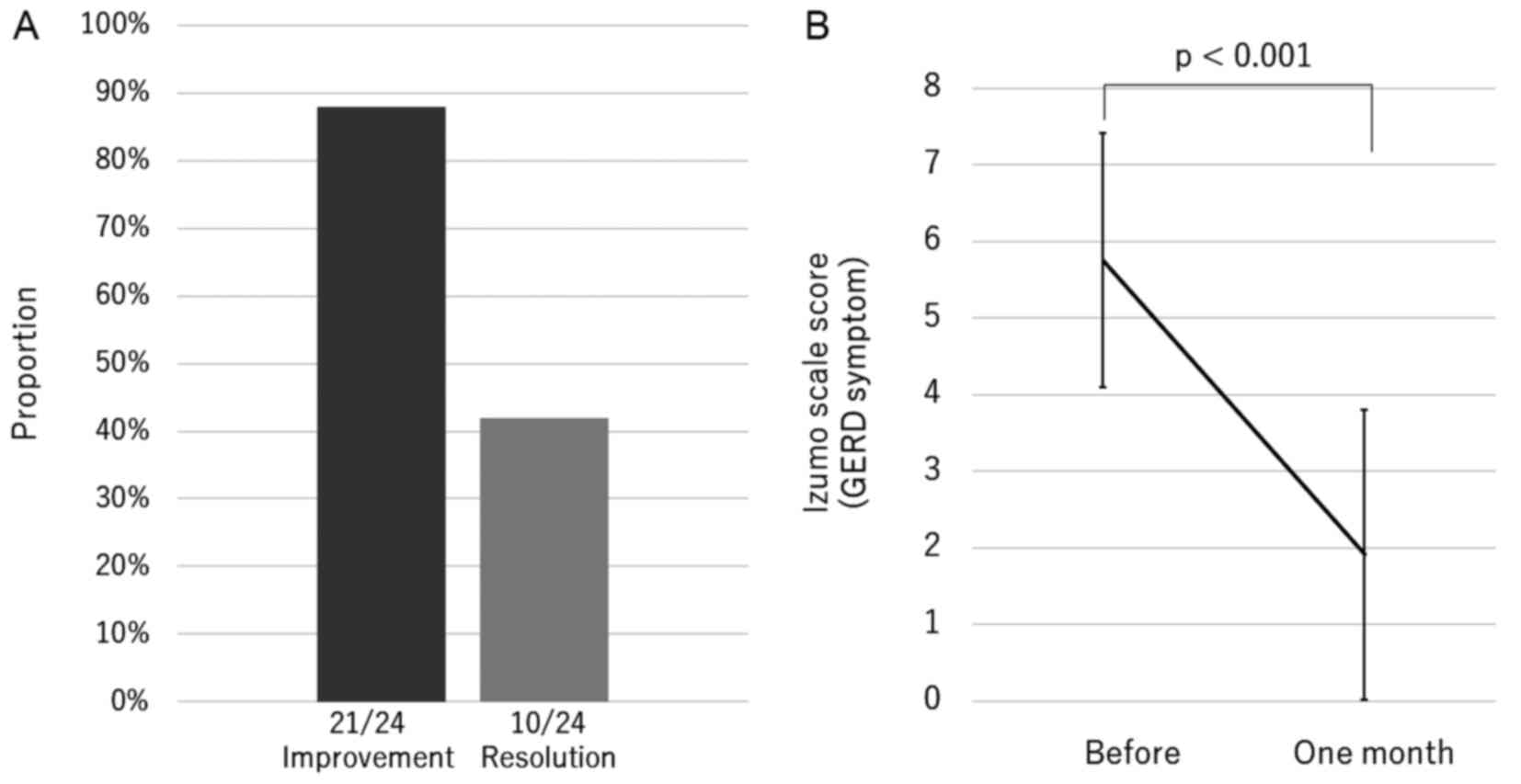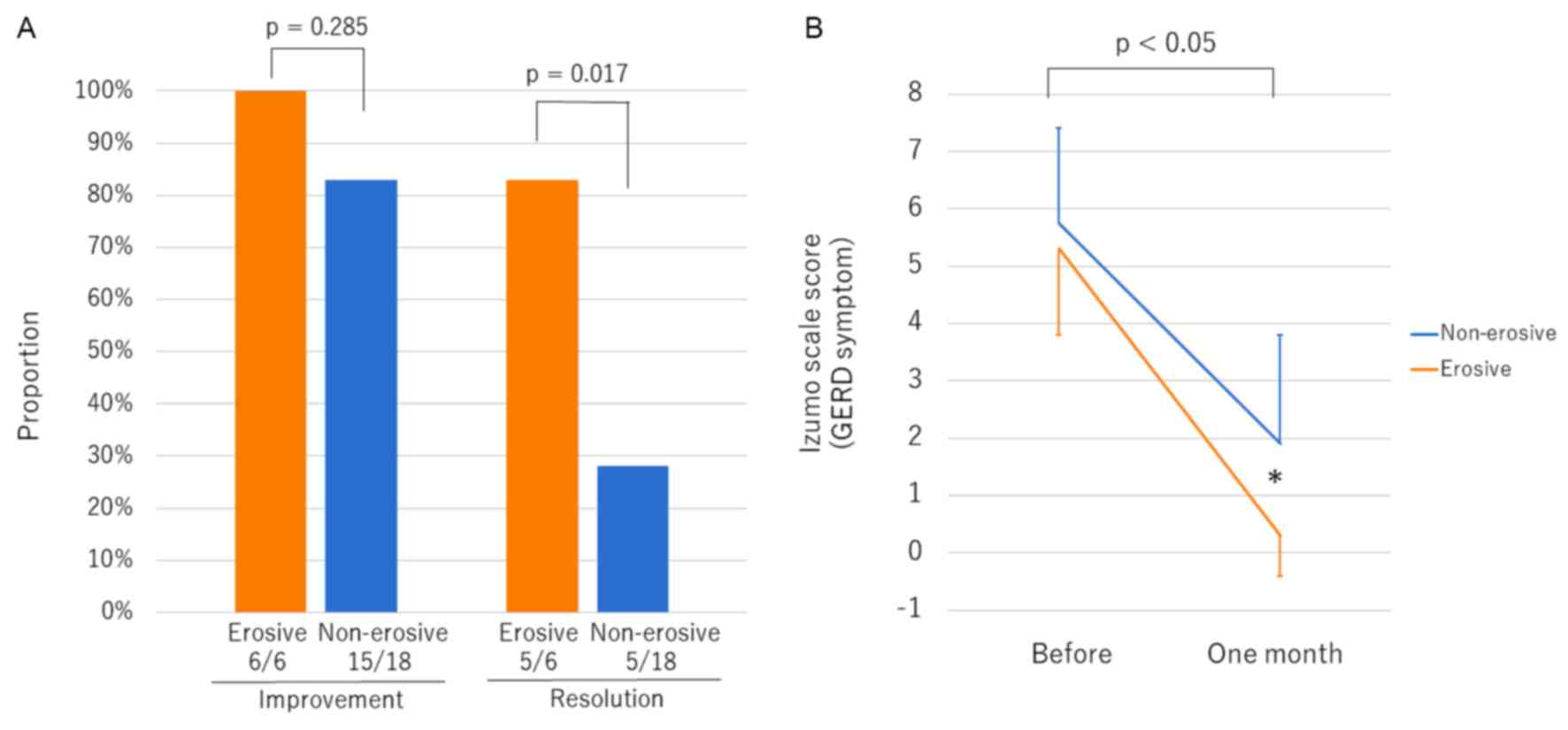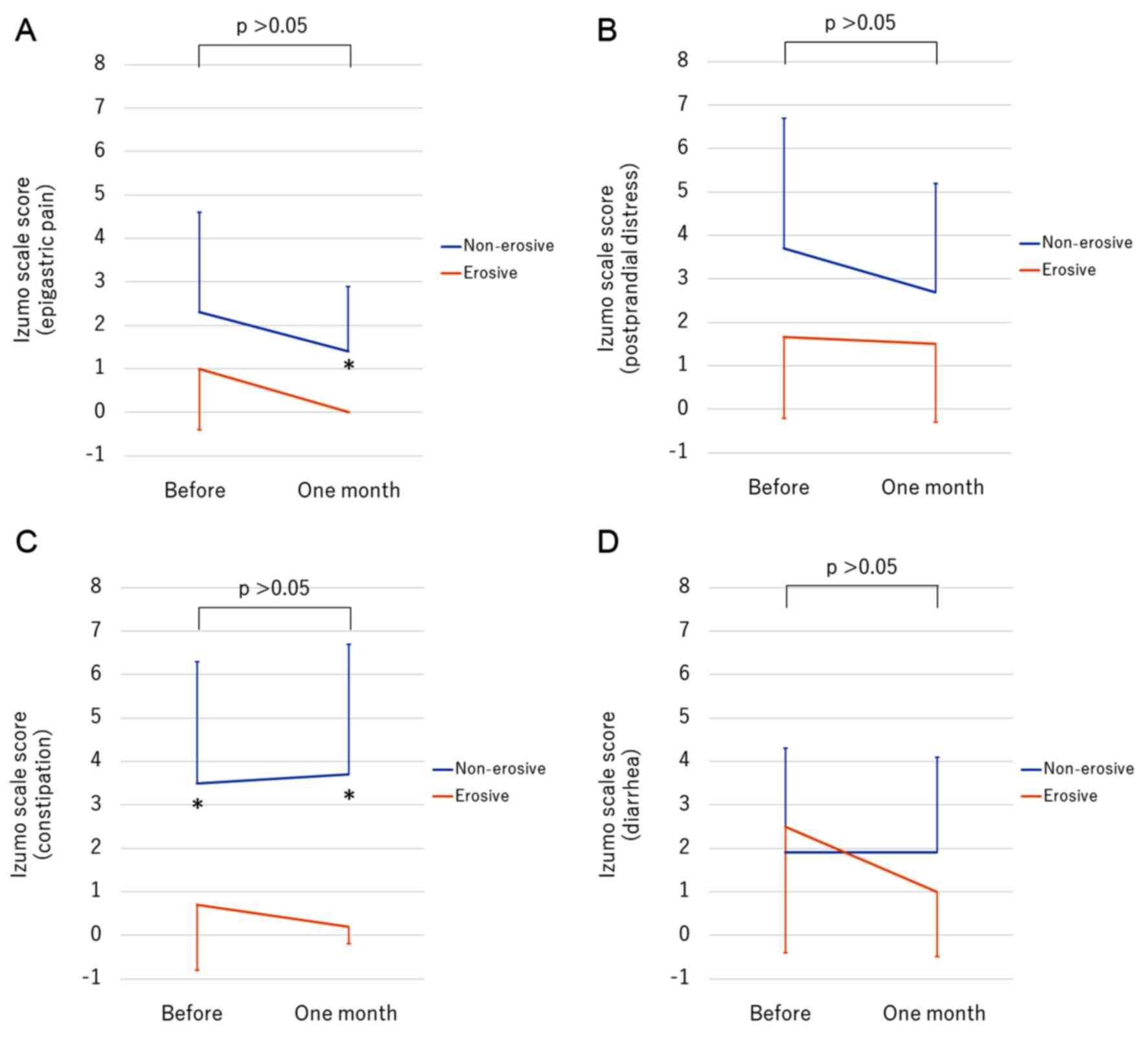Vonoprazan 10 mg daily is effective for the treatment of patients with proton pump inhibitor‑resistant gastroesophageal reflux disease
- Authors:
- Published online on: July 20, 2017 https://doi.org/10.3892/br.2017.947
- Pages: 231-235
Abstract
Introduction
Gastroesophageal reflux disease (GERD) is commonly treated by primary care physicians, and influences patients' overall quality of life (QOL) (1). Proton pump inhibitors (PPI) have been the mainstay of GERD treatment for two decades, and are recommended in Japanese guidelines (2). Despite evidence confirming the efficacy of PPI treatment, a Japanese survey reported over-the-counter medication use in patients who received prescriptions for GERD (3). Some patients with GERD are refractory to standard PPI treatment. Japanese guidelines define PPI-resistant GERD as a condition in which, i) an esophageal mucosal break did not heal and/or ii) reflux symptoms considered to be due to GERD are not sufficiently mitigated even after oral administration of PPI at a standard dose for eight weeks (2). To overcome treatment difficulties, double-dose PPI and/or additional administration of a prokinetic drug and herbal medicine were suggested. However, these unmet medical needs are not solved, and many patients with PPI-resistant GERD continue to suffer with impaired QOL (4).
Vonoprazan, a novel competitive acid blocker, became a first-choice drug for GERD and Helicobactor pylori (H. pylori) eradication therapy in Japan because of its strong acid inhibition, superior to PPI (5,6). Hoshino et al (7) reported the effect of vonoprazan 20 mg on patients with PPI-resistant reflux esophagitis with an 87.5% endoscopic healing rate and 76.2% of these patients did not recur even with a decreased dose of vonoprazan to 10 mg. These data encouraged us to evaluate the effect of vonoprazan 10 mg on GERD symptoms. Despite interest in the effect of vonoprazan in patients with PPI-resistant GERD, to the best of our knowledge, few data have been reported on the effect of vonoprazan on GERD symptoms. The effect of vonoprazan in patients with PPI-resistant GERD without erosive changes of the esophagus has not been well reported. The aim of the present study was to determine the effect of vonoprazan 10 mg in patients with PPI-resistant GERD.
Patients and methods
Twenty five patients with PPI-resistant GERD treated with vonoprazan 10 mg daily from February 2016 to February 2017, at Shinozaki Medical Clinic, were included in the present study. In this study, PPI-resistant GERD was defined as GERD symptoms not adequately improved even after a standard dose of PPI treatment for more than eight weeks. The Izumo scale in clinical practice to assess QOL of patients with gastrointestinal (GI) symptoms was routinely used (8). The following data were abstracted: Medical history, smoking habits, alcohol consumption, Izumo scale score, kind of PPI prior to vonoprazan treatment, acotiamide use, history of H. pylori eradication and endoscopic findings. H. pylori infection was assessed using serum anti-H. pylori antibody and/or the 13C-urea breath test. The degree of atrophy was determined based on the findings of esophagogastroduodenoscopy (EGD) using the Kimura-Takemoto classification, in which closed and open types correspond to mild and severe atrophy, respectively (9). Of 25 patients, one patient who was not followed for more than one month was excluded from the present study. Finally, 24 patients were included in the study cohort. The Institutional Review Board approved this retrospective study.
Izumo scale
The influence of GI symptoms on QOL of patients was evaluated by the Izumo scale, a validated and widely used questionnaire that assesses various abdominal symptoms (10–13). This scale has good internal consistency with the Gastrointestinal Symptom Rating Scale (12,14). It includes five domains with a total of 15 items: GERD (Q1-3), epigastric pain (Q4-6), postprandial distress (Q7-9), constipation (Q10-12) and diarrhea (Q13-15). Each item is scored 0 to 5 on a Likert scale based on the degree of symptoms: 0 = not bothered, 1 = not so bothered, 2 = slightly bothered, 3 = bothered, 4 = strongly bothered and 5 = intolerably bothered. Each domain has three items and thus has a total score from 0 to 15 points to assess the severity of each GI symptom assessed. A higher score reflects more severe symptoms. In this study, the score in the GERD domain of all patients were four or more points. We used the Izumo scale before and four weeks after starting vonoprazan. An ‘improvement of symptoms’ was defined as a score that was reduced by 50% or more, ‘resolution of symptoms’ as a score that was reduced to zero or one, and ‘aggravation of symptoms’ as a score that increased by four or more points from the initial score.
Statistical analysis
To compare scores of before and after the vonoprazan therapy, The Wilcoxon rank sum test was used, and to compare scores of groups, the Mann-Whitney U test was used. Data with a normal distribution were analyzed with Student's t-test, and categorical data were compared with the chi-squared test. Differences between variables with P<0.05 were considered significant. Statistical analysis was performed using BellCurve for Excel software (Social Survey Research Information Co., Ltd. Tokyo, Japan).
Results
Baseline characteristics of 24 patients with PPI-resistant GERD
The 24 study patients included 79% (19/24) females (Table I). All 24 patients underwent EGD prior to vonoprazan therapy and none had a current H. pylori infection. To evaluate the influence of erosions of the esophagus despite prior PPI treatment, we divided patients into erosive and non-erosive groups. An overall trend towards obesity was recognized, especially in the erosive group. The degree of GERD symptoms before starting vonoprazan were similar in both groups. Of the 24 patients, 46% (11/24) had a history of H. pylori eradication. Of the six patients in the erosive group, one, four and one patient had Los Angeles (LA) grades A, B and C erosions, respectively. The presence of hiatal hernia was significantly higher in the erosive group than in the non-erosive group (P=0.002). No patient had scleroderma.
Table I.Demographic data of patients with proton pump inhibitor (PPI)-resistant gastroesophageal reflux disease (GERD). |
Improvement and resolution rate of GERD symptoms using vonoprazan 10 mg daily
The overall rate of improvement and resolution of GERD symptoms were 88 and 42%, respectively, and the score significantly decreased to one-third of the pre-treatment value (before 5.8±1.7 and one month 1.9±1.9, P<0.001) (Fig. 1). Vonoprazan 10 mg daily resulted in >80% improvement regardless of the degree of esophageal erosion (Fig. 2A). Patients in the erosive group showed significantly higher rates of resolution than those in the non-erosive group (P=0.017). The score for GERD symptoms in the erosive group after one month of vonoprazan therapy decreased to almost zero, and the score was significantly lower than that of patients in the non-erosive group (P=0.008) (Fig. 2B). No aggravation of symptoms or adverse events were observed.
Vonoprazan effect on other GI symptoms in patients with PPI-resistant GERD
We evaluated other GI symptoms associated with GERD before and after vonoprazan therapy. The scores for epigastric pain comparing the erosive and the non-erosive groups were not significantly different before therapy (P=0.191), but the scores after treatment were significantly lower in the erosive group than in the non-erosive group (P=0.025) (Fig. 3A). The scores for postprandial distress in the non-erosive group showed a higher trend compared to the erosive group, without a statistically significant difference (Fig. 3B). Although vonoprazan therapy did not affect the score for constipation, the non-erosive group showed a significantly higher score for constipation than the erosive group both before and one month after starting vonoprazan (Fig. 3C). Vonoprazan therapy did not affect the score for diarrhea (Fig. 3D).
Discussion
To the best of our knowledge, this is the first report evaluating the efficacy of vonoprazan 10 mg in patients with PPI-resistant GERD and other GI symptoms. Vonoprazan 10 mg resulted in an 80% improvement regardless of the presence of erosions, and had a significantly improved rate of resolution in patients in the erosive group who had healed after adequate PPI treatment than the non-erosive group.
Not limited to PPI-resistant GERD, patients with erosions are more responsive to PPI therapy than those without erosions in naïve GERD (15). The presence of erosions despite standard PPI regimen suggests insufficient gastric acid inhibition and thus stronger suppression via an alternative mechanism is necessary. Unlike PPIs, acid inhibition by vonoprazan is not influenced by the CYP2C19 genotype, and its acid inhibition is superior to PPIs such as esomeprazole (16). The present study shows that vonoprazan 10 mg daily resulted in a 100% improvement and 83% resolution of the GERD symptoms in patients with erosions. A recent Japanese study reported an 88% (21/24) endoscopic healing rate by vonoprazan 20 mg daily for four weeks in patients with PPI-resistant reflux esophagitis (7). The healing rate is similar to the resolution rate of GERD symptom in the present study. Baseline LA classifications were mainly grade B or greater (21/24, 88%) in their study (7) and 83% (5/6) in the present study. A moderate or severe LA grade may exist frequently in patients with PPI-resistant reflux esophagitis. Although the optimal dose of vonoprazan for patients with erosions and PPI-resistant GERD remains unclear, we believe that vonoprazan 10 mg daily is a viable choice for patients with PPI-resistant GERD.
Few reports are available regarding the effect of vonoprazan on patients with PPI-resistant GERD without erosions. Despite an 83% improvement in the non-erosive group, the rate of resolution (28%) is significantly lower than in the erosive group. As a matter of course, non-erosive GERD is caused by heterogenous conditions related not only to gastric acid but also GI motility and sensitivity (15). The influence of gastric acid is less in patients with non-erosive GERD than in patients with erosive GERD, and strong acid inhibition by vonoprazan may therefore be less effective in patients with non-erosive GERD than in those with erosive GERD. Patients in the non-erosive group in this study had a trend towards worse epigastric pain, postprandial distress and constipation than those in the erosive group. The presence of other GI symptoms may be partially associated with the attenuated effect of vonoprazan in patients without erosions. Additional use of prokinetic drugs or cathartics may be suitable to resolve other symptoms related to GERD in patients without erosions.
Japanese guidelines recommend a double-dose of PPI, additional use of prokinetic drugs, histamine-2 receptor antagonist (H2RA) or herbal medicine for the treatment of patients with PPI-resistant GERD (2). A randomized controlled trial reported that dose escalation of rabeprazole improved endoscopic mucosal healing in patients with PPI-resistant GERD with erosions (17). A multicenter observational study reported that double-dose PPI improved long-term QOL in patients with PPI-resistant GERD with erosions (18). Therefore, strong acid suppression is effective and justified for patients with PPI-resistant GERD with erosions. Although the addition of bedtime H2RA is effective for nocturnal acid breakthrough in the short-term, its effect cannot be maintained because of H2RA tolerance (19). Since vonoprazan maintains the gastric pH level for 24 h, vonoprazan may be a promising acid suppressor for the treatment of nocturnal acid breakthrough (5). Vonoprazan directly inhibits H+-K+ exchange on the gastric luminal surface via an alternative mechanism, unlike PPIs, and its effect is not influenced by the CYP2C19 genotype (16). Therefore, vonoprazan may be useful for patients with PPI-resistant GERD, especially in patients who rapidly metabolize these medications. Furthermore, vonoprazan may decrease the need for anti-reflux surgery in patients with PPI-resistant GERD.
There are some acknowledged limitations in the present study. First, this is a single-center retrospective study with a small number of patients. Second, patients and doctors were not blinded to the therapy used. Third, the variety of PPIs used before vonoprazan therapy were not homogeneous but a standard dose. Fourth, the presence of the CYP2C19 genotype was not investigated. A large prospective study is necessary to clarify the optimal dose of vonoprazan for patients with erosive and non-erosive PPI-resistant GERD.
In conclusion, this retrospective cohort study shows satisfactory effectiveness of vonoprazan 10 mg daily in patients with PPI-resistant GERD. Vonoprazan resolves GERD symptoms in patients with erosions rather than those without erosions. Since previous studies only used vonoprazan 20 mg daily, to the best of our knowledge, this is the first study to describe the effect of vonoprazan 10 mg in patients with PPI-resistant GERD. We believe that vonoprazan 10 mg daily may become a first-line treatment for patients with PPI-resistant GERD, but further study is necessary.
Glossary
Abbreviations
Abbreviations:
|
GERD |
gastroesophageal reflux disease |
|
QOL |
quality of life |
|
PPI |
proton pump inhibitor |
|
GI |
gastro-intestinal |
|
H2RA |
histamine-2 receptor antagonist |
|
EGD |
esophagogastro-duodenoscopy |
|
LA |
Los Angeles |
References
|
Dimenäs E: Methodological aspects of evaluation of Quality of Life in upper gastrointestinal diseases. Scand J Gastroenterol Suppl. 199:18–21. 1993. View Article : Google Scholar : PubMed/NCBI | |
|
Iwakiri K, Kinoshita Y, Habu Y, Oshima T, Manabe N, Fujiwara Y, Nagahara A, Kawamura O, Iwakiri R, Ozawa S, et al: Evidence-based clinical practice guidelines for gastroesophageal reflux disease 2015. J Gastroenterol. 51:751–767. 2016. View Article : Google Scholar : PubMed/NCBI | |
|
Suzuki H, Matsuzaki J, Okada S, Hirata K, Fukuhara S and Hibi T: Validation of the GerdQ questionnaire for the management of gastro-oesophageal reflux disease in Japan. United European Gastroenterol J. 1:175–183. 2013. View Article : Google Scholar : PubMed/NCBI | |
|
Toghanian S, Johnson DA, Stålhammar NO and Zerbib F: Burden of gastro-oesophageal reflux disease in patients with persistent and intense symptoms despite proton pump inhibitor therapy: A post hoc analysis of the 2007 national health and wellness survey. Clin Drug Investig. 31:703–715. 2011. View Article : Google Scholar : PubMed/NCBI | |
|
Sakurai Y, Mori Y, Okamoto H, Nishimura A, Komura E, Araki T and Shiramoto M: Acid-inhibitory effects of vonoprazan 20 mg compared with esomeprazole 20 mg or rabeprazole 10 mg in healthy adult male subjects-a randomised open-label cross-over study. Aliment Pharmacol Ther. 42:719–730. 2015. View Article : Google Scholar : PubMed/NCBI | |
|
Shinozaki S, Nomoto H, Kondo Y, Sakamoto H, Hayashi Y, Yamamoto H, Lefor AK and Osawa H: Comparison of vonoprazan and proton pump inhibitors for eradication of Helicobacter pylori. Kaohsiung J Med Sci. 32:255–260. 2016. View Article : Google Scholar : PubMed/NCBI | |
|
Hoshino S, Kawami N, Takenouchi N, Umezawa M, Hanada Y, Hoshikawa Y, Kawagoe T, Sano H, Hoshihara Y, Nomura T, et al: Efficacy of vonoprazan for proton pump inhibitor-resistant reflux esophagitis. Digestion. 95:156–161. 2017. View Article : Google Scholar : PubMed/NCBI | |
|
Kakuta E, Yamashita N, Katsube T, Kushiyama Y, Suetsugu H, Furuta K and Kinoshita Y: Abdominal symptom-related QOL in individuals visiting an outpatient clinic and those attending an annual health check. Intern Med. 50:1517–1522. 2011. View Article : Google Scholar : PubMed/NCBI | |
|
Kimura K and Takemoto T: An endoscopic recognition of the atrophic border and its significance in chronic gastritis. Endoscopy. 1:87–97. 1969. View Article : Google Scholar | |
|
Shinozaki S, Osawa H, Sakamoto H, Hayashi Y, Lefor A Kawarai and Yamamoto H: The effect of acotiamide on epigastric pain syndrome and postprandial distress syndrome in patients with functional dyspepsia. J Med Invest. 63:230–235. 2016. View Article : Google Scholar : PubMed/NCBI | |
|
Yoshioka T, Okimoto N, Okamoto K and Sakai A: A comparative study of the effects of daily minodronate and weekly alendronate on upper gastrointestinal symptoms, bone resorption, and back pain in postmenopausal osteoporosis patients. J Bone Miner Metab. 31:153–160. 2013. View Article : Google Scholar : PubMed/NCBI | |
|
Okimoto E, Ishimura N, Morito Y, Mikami H, Shimura S, Uno G, Tamagawa Y, Aimi M, Oshima N, Kawashima K, et al: Prevalence of gastroesophageal reflux disease in children, adults, and elderly in the same community. J Gastroenterol Hepatol. 30:1140–1146. 2015. View Article : Google Scholar : PubMed/NCBI | |
|
Kinoshita Y and Chiba T: FUTURE study group: Therapeutic effects of famotidine on chronic symptomatic gastritis: Subgroup analysis from FUTURE study. J Gastroenterol. 47:377–386. 2012. View Article : Google Scholar : PubMed/NCBI | |
|
Kinoshita Y and Chiba T: FUTURE study group: Characteristics of Japanese patients with chronic gastritis and comparison with functional dyspepsia defined by ROME III criteria: Based on the large-scale survey, FUTURE study. Intern Med. 50:2269–2276. 2011. View Article : Google Scholar : PubMed/NCBI | |
|
Tack J and Fass R: Review article: approaches to endoscopic-negative reflux disease: part of the GERD spectrum or a unique acid-related disorder? Aliment Pharmacol Ther 19. Suppl 1:28–34. 2004. View Article : Google Scholar | |
|
Kagami T, Sahara S, Ichikawa H, Uotani T, Yamade M, Sugimoto M, Hamaya Y, Iwaizumi M, Osawa S, Sugimoto K, et al: Potent acid inhibition by vonoprazan in comparison with esomeprazole, with reference to CYP2C19 genotype. Aliment Pharmacol Ther. 43:1048–1059. 2016. View Article : Google Scholar : PubMed/NCBI | |
|
Kinoshita Y and Hongo M: Japan TWICE study group: Efficacy of twice-daily rabeprazole for reflux esophagitis patients refractory to standard once-daily administration of PPI: The Japan-based TWICE study. Am J Gastroenterol. 107:522–530. 2012. View Article : Google Scholar : PubMed/NCBI | |
|
Kinoshita Y, Hongo M, Kusano M, Furuhata Y, Miyagishi H and Ikeuchi S: RPZ Study Group: Therapeutic response to twice-daily Rabeprazole on health-related quality of life and symptoms in patients with refractory reflux esophagitis: A multicenter observational study. Intern Med. 56:1131–1139. 2017. View Article : Google Scholar : PubMed/NCBI | |
|
Fackler WK, Ours TM, Vaezi MF and Richter JE: Long-term effect of H2RA therapy on nocturnal gastric acid breakthrough. Gastroenterology. 122:625–632. 2002. View Article : Google Scholar : PubMed/NCBI |












